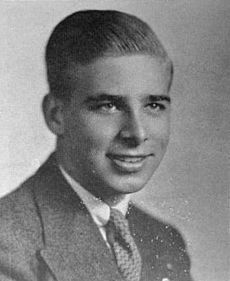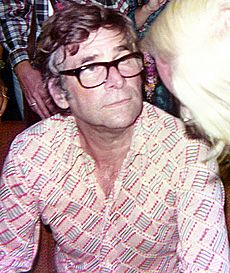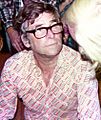Gene Roddenberry facts for kids
Quick facts for kids
Gene Roddenberry
|
|
|---|---|
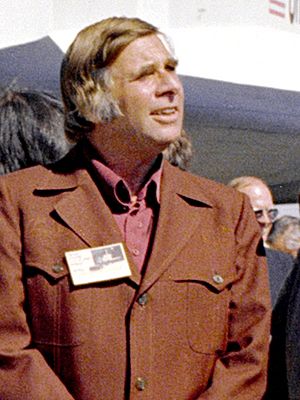
Roddenberry with Space Shuttle Enterprise in Palmdale, California (1976)
|
|
| Born |
Eugene Wesley Roddenberry
August 19, 1921 El Paso, Texas, U.S.
|
| Died | October 24, 1991 (aged 70) Santa Monica, California, U.S.
|
| Other names | Robert Wesley |
| Alma mater | Los Angeles City College |
| Occupation | Television writer, producer |
| Spouse(s) |
|
| Partner(s) | Susan Sackett (1975–1991; his death) |
| Children | 3, including Rod |
Eugene Wesley Roddenberry Sr. (born August 19, 1921 – died October 24, 1991) was an American television writer and producer. He is best known for creating the famous science fiction series Star Trek: The Original Series. He also created its animated spin-off, Star Trek: The Animated Series, and Star Trek: The Next Generation.
Roddenberry was born in El Paso, Texas, and grew up in Los Angeles. His father was a police officer. During World War II, Roddenberry flew 89 combat missions for the Army Air Forces. After the war, he worked as a commercial pilot. He then joined the Los Angeles Police Department, following in his father's footsteps. While working as a police officer, he started writing scripts for television shows.
As a writer, Roddenberry wrote for shows like Highway Patrol and Have Gun – Will Travel. Later, he created and produced his own series, The Lieutenant. In 1964, he developed Star Trek, which first aired in 1966. The show ran for three seasons before it was canceled. After Star Trek, he worked on other TV projects, but they were not as successful.
However, Star Trek became very popular when it was shown again in reruns. This led to the creation of the Star Trek feature films. Roddenberry continued to produce and advise on these movies. In 1987, a new series, Star Trek: The Next Generation, began. Roddenberry was very involved in creating this show. He continued to advise on the series until he passed away in 1991.
In 1985, Gene Roddenberry became the first TV writer to get a star on the Hollywood Walk of Fame. He was also added to the Science Fiction Hall of Fame and the Academy of Television Arts & Sciences Hall of Fame. Years after his death, some of his ashes were even sent into Earth's orbit. The Star Trek universe he created has inspired many films, books, comic books, and video games.
Contents
Gene Roddenberry's Early Life and Career
Gene Roddenberry was born on August 19, 1921, in El Paso, Texas. He was the first child of Eugene Edward and Caroline Roddenberry. In 1923, his family moved to Los Angeles after his father became a police officer there. As a child, Roddenberry loved to read, especially adventure stories from pulp magazines. He enjoyed tales like John Carter of Mars and Tarzan.
Roddenberry studied police science at Los Angeles City College. There, he became interested in aeronautical engineering. He earned a pilot's license through a program sponsored by the United States Army Air Corps. He joined the USAAC on December 18, 1941, and became a second lieutenant in August 1942.
He was sent to Bellows Field in Hawaii. He joined the 394th Bomb Squadron, which flew Boeing B-17 Flying Fortress planes. On August 2, 1943, a plane he was piloting crashed after overshooting the runway. Two men died in the accident. An official report said Roddenberry was not responsible. He spent the rest of his military career in the United States, investigating plane crashes. He was involved in another plane crash as a passenger. He received the Distinguished Flying Cross and the Air Medal for his service.
In 1945, Roddenberry started flying for Pan American World Airways. He flew on long routes, including from New York to Johannesburg. On June 18, 1947, he was in his third plane crash in the Syrian Desert. He broke two ribs but helped pull injured passengers from the burning plane. Fourteen people died in this crash. Roddenberry left Pan Am in May 1948 to focus on his dream of writing for television.
Roddenberry joined the Los Angeles Police Department in January 1949. He worked in the traffic division before moving to the Public Information Division. He became the Chief of Police's speech writer. In this role, he also helped the popular TV series Dragnet. He wrote short stories based on real police cases for the show. He also wrote for Mr. District Attorney under the name "Robert Wesley". He sold scripts to Highway Patrol as well. By 1956, it was hard to be both a writer and a police officer. So, on June 7, 1956, he left the police force to become a full-time writer.
Becoming a Full-Time Writer and Producer
Early Writing Career
Roddenberry became the head writer for The West Point Story, writing many episodes. In 1956, he tried to sell a series to CBS called Hawaii Passage, set on a cruise ship. He wanted to be a producer and have full creative control, but CBS did not buy the idea. He also worked on a show called Junior Executive but it did not go anywhere.
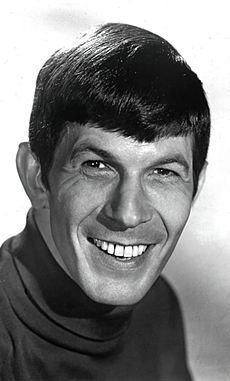
He wrote scripts for other series, such as Bat Masterson. His episode of Have Gun – Will Travel, "Helen of Abajinian", won an award from the Writers Guild of America in 1958. He also created new series ideas, like The Man from Lloyds, about an agent for Lloyd's of London. He pitched a police series called Footbeat to several networks, but it was not picked up.
Roddenberry was asked to write a series called Riverboat, set in 1860s Mississippi. He disagreed with the producers who did not want any black characters on the show. He argued so much that he lost the job. He then signed a contract with Screen Gems, which included a guaranteed $100,000. This allowed him to become a producer for the first time on a show called Wrangler.
Screen Gems supported Roddenberry's first attempt to create a pilot episode. His series, The Wild Blue, was filmed but not chosen by a network. Some character names from this pilot, like Philip Pike and Edward Jellicoe, later appeared in Star Trek. While at Screen Gems, he met actress Majel Leigh Hudec, who later became Majel Barrett. They became good friends. He created another pilot called 333 Montgomery about a lawyer, starring DeForest Kelley. This pilot was also not picked up.
In 1961, Roddenberry appeared in an advertisement for MONY (Mutual of New York). With money from his writing, he and his wife Eileen moved to a new home near Beverly Hills. He had an idea for a show about a diverse crew on an airship traveling the world. Since science fiction was not popular at the time, he started working on The Lieutenant for NBC. This show premiered on September 14, 1963, and was very popular. Roddenberry worked with several actors and crew members who would later join him on Star Trek, including Leonard Nimoy, Nichelle Nichols, and Majel Barrett.
The Lieutenant was made with help from the Pentagon, allowing filming at a Marine base. Roddenberry often disagreed with the Department of Defense about story ideas. The department stopped supporting the show when Roddenberry insisted on an episode called "To Set It Right". This episode showed a white and a black Marine finding common ground. This was the first time he worked with Nichelle Nichols. The show was not renewed after its first season. Roddenberry was already developing a new series idea. This idea combined his ship setting from Hawaii Passage with a diverse crew. He decided to make it a science fiction story. By March 1964, he had a 16-page pitch for his new series, which he called Star Trek.
Creating Star Trek
When Roddenberry first pitched Star Trek to MGM, they liked it but did not offer a deal. He then went to Desilu Productions. Instead of just a script deal, he was hired as a producer and could work on his own projects. His first project, a pilot called Police Story, was not picked up. Desilu was having financial problems, so Roddenberry took the Star Trek idea to Oscar Katz, head of programming. They tried to sell the show to CBS, but CBS passed on it because they were developing their own science fiction series, Lost in Space.
Roddenberry and Katz then pitched Star Trek to NBC. This time, they focused less on the science fiction and more on how it was like popular Western shows. NBC agreed to fund three story ideas and chose "The Cage" for the pilot episode. Desilu covered some of the costs. Roddenberry hired D. C. Fontana as his assistant; she had worked with him on The Lieutenant.

Roddenberry wrote the character of Number One in the pilot specifically for Majel Barrett. Barrett suggested Leonard Nimoy for the role of Spock. Nimoy had worked with Roddenberry before. Filming for the pilot began on November 27, 1964. After it was finished, NBC executives watched it. However, test audiences did not like the episode. Oscar Katz offered to make a second pilot. On March 26, 1965, NBC ordered a new episode.
Roddenberry developed several new scripts, and NBC chose "Where No Man Has Gone Before". Roddenberry was determined to have a racially diverse crew, which impressed actor George Takei during his audition. This episode was filmed for about half the cost of the first pilot. In December, Roddenberry wrote lyrics for the Star Trek theme song. This upset the composer, Alexander Courage, because it meant they would share royalties. In February 1966, NBC announced they would buy Star Trek for their fall schedule.
The first episode of Star Trek began production on May 24, 1966. Five days before the first broadcast, Roddenberry showed "Where No Man Has Gone Before" at a science fiction convention. He received a standing ovation. The first episode to air on NBC was "The Man Trap" on September 8, 1966. Roddenberry was worried about the show's low ratings. He asked famous science fiction writer Harlan Ellison to help save the show by writing letters to the network. He also talked with writer Isaac Asimov about Spock's growing popularity. Asimov suggested having Kirk and Spock work together as a team. NBC renewed the series for a full season, and then for a second season.
Roddenberry often rewrote scripts submitted by other writers, sometimes without taking credit. He had creative differences with some writers, including Harlan Ellison and Don Ingalls, over changes to their scripts. A dispute over his rewriting of "The Menagerie" went to a Writers Guild board, which ruled in his favor. This script won a Hugo Award.
As the second season ended, Star Trek faced cancellation again. Roddenberry sought help from Isaac Asimov and encouraged a student protest march at NBC. On January 8, 1968, a thousand students marched on the studio. Roddenberry also worked with fan Bjo Trimble, who led a letter-writing campaign to save the series. The network received about 6,000 letters a week from fans. On March 1, 1968, NBC announced that Star Trek would return for a third season.
NBC initially planned to move Star Trek to a better time slot. However, a powerful producer objected, and Star Trek was moved to 10:00 pm on Fridays. Knowing the show could not survive in that late slot, and tired of arguments with the network, Roddenberry stepped back from the daily running of Star Trek. He was still credited as executive producer. He also co-wrote a non-fiction book about the show called The Making of Star Trek. NBC announced Star Trek's cancellation in February 1969. The last episode aired 47 days before Neil Armstrong walked on the moon. Roddenberry said he would never write for television again.
Projects in the 1970s
After Star Trek was canceled, Roddenberry felt he was only seen as a science fiction producer. He said his dreams were "going downhill" because he could not find work. He felt he was seen as "the guy who made the show that was an expensive flop." Roddenberry had sold his share in Star Trek to Paramount Studios. However, he did not make money from it quickly.
To earn money, he started giving college lectures and appearing at science fiction conventions. He showed clips from Star Trek, including blooper reels. These conventions helped build fan support to bring Star Trek back. In 1972, TV Guide called it "the show that won't die."
In 1972 and 1973, Roddenberry returned to science fiction. He sold ideas for four new series. One was Genesis II, set on a post-apocalyptic Earth. He hoped to create a new hit show. The pilot aired as a TV movie in March 1973 and was very popular. However, CBS decided to make a television series based on the film Planet of the Apes instead. This show was not successful.
Another project was The Questor Tapes, which reunited him with writer Gene L. Coon. NBC ordered 16 episodes, and the pilot aired in January 1974. It received good reviews, but Roddenberry left the project because he disagreed with the network's requested changes. This led to its cancellation. In 1974, Roddenberry reworked Genesis II into a second pilot, Planet Earth, for ABC. This also had limited success. He was not involved in a third version of the story. He also developed MAGNA I, an underwater science fiction series, and Tribunes, a science fiction police series, but neither made it to production.
In 1977, Roddenberry's pilot Spectre, about two occult detectives, was released as a TV movie.
Star Trek Returns
In the early 1970s, Roddenberry did not have enough money to buy the full rights to Star Trek from Paramount. In 1973, Lou Scheimer approached Paramount about an animated Star Trek series. Roddenberry was hired as an "executive consultant" and given creative control for Star Trek: The Animated Series. He read all the scripts and added his own ideas, but much of the daily work was done by D. C. Fontana.
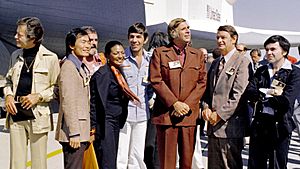
Roddenberry had some issues with the cast. To save money, he initially did not want to hire George Takei and Nichelle Nichols. He told Leonard Nimoy that he was the only main cast member returning. When Nimoy found out, he insisted that Takei and Nichols play Sulu and Uhura. Roddenberry agreed. He was promised five seasons of the animated show, but only one and a half were made.
Strong fan support, with thousands attending Star Trek conventions, led Paramount to hire Roddenberry in May 1975 to create a feature film based on the franchise. Several ideas were developed, including Star Trek: The God Thing and Star Trek: Planet of the Titans. After the success of Star Wars, Paramount decided in June 1977 to create a new live-action series called Star Trek: Phase II. Roddenberry and most of the original cast were set to return, except for Nimoy.
This new series was planned to be the main show for a new network Paramount wanted to start. However, the network plans were canceled, and the project was turned into a feature film. The result was Star Trek: The Motion Picture. The film had budget problems but was a box-office hit. It is one of the highest-grossing Star Trek movies when adjusted for inflation.
In 1980, Roddenberry suggested a sequel film where the crew would stop the Klingons from preventing the assassination of John F. Kennedy. Paramount rejected this idea. He was replaced by producer Harve Bennett for the next film. Roddenberry became an "executive consultant" for future Star Trek films during his lifetime. He received a fee and a percentage of the profits for giving notes and talking with fans. However, his notes were often not used by the producers. About 20% of the plot for Star Trek II: The Wrath of Khan was based on Roddenberry's ideas.
Roddenberry was involved in creating the television series Star Trek: The Next Generation, which premiered on September 28, 1987. He received a $1 million bonus and a salary to produce the series. He bought a new Rolls-Royce with some of the money. Paramount was worried about the original cast not returning, and they feared fan reaction if Roddenberry was not involved. So, they agreed to his demand for control of the show. Roddenberry rewrote the series guide from an earlier version by David Gerrold.
According to producer Rick Berman, Roddenberry's involvement in The Next Generation "diminished greatly" after the first season. However, this was not widely known because his name was important to fans. His last writing credit on the show was for "Datalore" in the first season. The early seasons of The Next Generation faced challenges with the writing staff.
In 1990, Nicholas Meyer was brought in to direct the sixth film, Star Trek VI: The Undiscovered Country. Meyer and Roddenberry had creative differences. Roddenberry felt that the Enterprise crew showing prejudice against the Klingons did not fit his vision of the future. According to Joel Engel's biography, Roddenberry watched The Undiscovered Country two days before his death and told the producers they had done a "good job." However, other accounts say he wanted many scenes cut.
Roddenberry wrote the novelization of Star Trek: The Motion Picture. This was the first of hundreds of Star Trek novels published by Pocket Books.
Personal Life
While at Los Angeles City College, Roddenberry began dating Eileen-Anita Rexroat. They got engaged before he left Los Angeles for military service and married on June 20, 1942. They had two daughters, Darleen Anita and Dawn Allison.
Roddenberry later married Majel Barrett in a Shinto ceremony in Japan in 1969. They had a son together, Eugene Jr., known as Rod Roddenberry, born in February 1974.
Health and Passing
In the late 1980s, Gene Roddenberry began to suffer from cerebral vascular disease and encephalopathy, which are conditions affecting the brain.
After a stroke in September 1989, his health worsened. He eventually needed to use a wheelchair. Another stroke in October 1991 paralyzed his right arm, causing pain and problems with his right eye. He also found it hard to speak in full sentences. On October 24, 1991, he had an appointment with his doctor in Santa Monica, California. While in the elevator, he struggled to breathe. He was taken to the doctor's office, where a nurse gave him oxygen. His wife, Majel Barrett, arrived and held him. He then suffered cardiopulmonary arrest and passed away in the doctor's office. He was 70 years old.
His funeral was held on November 1 at the Hall of Liberty in Hollywood Hills. It was a non-religious service, as Roddenberry had been cremated earlier. More than 300 Star Trek fans attended. Nichelle Nichols sang two songs, including one she wrote for him called "Gene." Several people spoke at the memorial, including Ray Bradbury and Whoopi Goldberg. The ceremony ended with bagpipes playing "Amazing Grace" and a recorded message from Roddenberry. A four-plane flypast in the missing man formation followed. After his death, Star Trek: The Next Generation aired a two-part episode called "Unification" with a dedication to Roddenberry.
Roddenberry's will left most of his estate to Majel Barrett in a trust. He also left money to his children and his first wife, Eileen. His daughter Dawn challenged the will. After legal proceedings, the California Court of Appeals ruled in 1996 that the original will would stand.
Spaceflight
In 1992, some of Roddenberry's ashes were carried into space and returned to Earth on the Space Shuttle Columbia mission STS-52. On April 21, 1997, a Celestis spacecraft carried a small amount of his ashes, along with those of other people, into Earth orbit. The spacecraft's orbit decayed, and it burned up in the atmosphere on May 20, 2002. Another flight to launch more of his ashes into deep space, along with those of Majel Barrett and James Doohan, was planned but later canceled.
Gene Roddenberry's Legacy
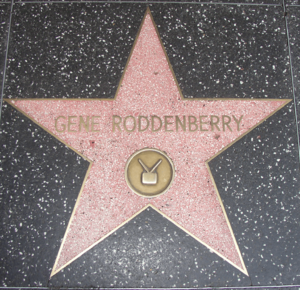
In 1985, Gene Roddenberry became the first television writer to receive a star on the Hollywood Walk of Fame. When the Sci-Fi Channel launched, its first broadcast was dedicated to him and Isaac Asimov. The Roddenberry crater on Mars is named after him, as is the asteroid 4659 Roddenberry. Roddenberry and Star Trek have inspired other science fiction creators. George Lucas said Star Trek helped make Star Wars possible. J. Michael Straczynski, creator of Babylon 5, admired Star Trek for its ideas about humanity's future.
A biography titled Star Trek Creator was published in 1995. Yvonne Fern's book Gene Roddenberry: The Last Conversation shared talks she had with him in his final months. In October 2002, a plaque was placed at his birthplace in El Paso, Texas. The El Paso Independent School District named the Roddenberry Planetarium in his honor. He was inducted into the Science Fiction Hall of Fame in 2007 and the Television Academy Hall of Fame in 2010.
To celebrate Roddenberry's 100th birthday in August 2021, NASA sent a recording of him from 1976 towards the star system 40 Eridani (the home of the fictional planet Vulcan). The signal will reach the star in 2038.
TV Series After His Death
Star Trek: Deep Space Nine was already being developed when Roddenberry passed away. Producer Rick Berman said Roddenberry gave his blessing for the show. Berman noted that while he didn't believe the 24th century would be completely free of problems as Roddenberry imagined, working on Star Trek meant embracing that hopeful vision.
In 1996, Majel Barret-Roddenberry found scripts for a series called Battleground Earth. This project was picked up and renamed Earth: Final Conflict. It premiered in 1997, six years after Gene's death, and ran for five seasons until 2002.
Two more series ideas were developed from Roddenberry's notes: Genesis and Andromeda. Andromeda aired for five seasons from 2000 to 2005. Rod Roddenberry, Gene's son, announced in 2010 that he planned to bring The Questor Tapes to television. Rod also created a two-hour TV movie called Trek Nation about his father's impact.
Awards and Honors
Most of the awards and nominations Roddenberry received were for Star Trek. He was nominated for two Emmy Awards for Star Trek. He won two Hugo Awards: one special award for the series, and another for the episode "The Menagerie." He also received the Brotherhood Award from the National Association for the Advancement of Colored People for promoting African American characters on television.
After Star Trek ended, he was nominated for Hugo Awards for Genesis II and The Questor Tapes. After his death in 1991, he was honored with the Robert A. Heinlein Memorial Award and The George Pal Memorial Award. He also received the Exceptional Public Service Medal from NASA.
See also
 In Spanish: Gene Roddenberry para niños
In Spanish: Gene Roddenberry para niños
Images for kids


